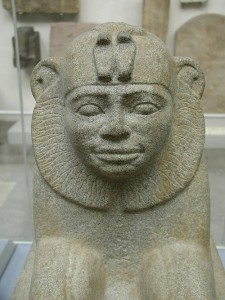

Taharqa was a pharaoh of the Ancient Egyptian 25th dynasty and king of the Kingdom of Kush, which was located in Northern Sudan.
Taharqa was the son of Piye, the Nubian king of Napata who had first conquered Egypt. Taharqa was also the cousin and successor of Shebitku. The successful campaigns of Piye and Shabaka paved the way for a prosperous reign by Taharqa.Taharqa’s reign can be dated from 690 BC to 664 BC.Evidence for the dates of his reign is derived from the Serapeum stela, catalog number 192. This stela records that an Apis bull born and installed (fourth month of Peret, day 9) in Year 26 of Taharqa died in Year 20 of Psammetichus I (4th month of Shomu, day 20), having lived 21 years. This would give Taharqa a reign of 26 years and a fraction, in 690-664 B.C. Taharqa explicitly states in Kawa Stela V, line 15, that he succeeded Shebitku with this statement: “I received the Crown in Memphis after the Falcon (i.e., Shebitku) flew to heaven.”
Although Taharqa’s reign was filled with conflict with the Assyrians, it was also a prosperous renaissance period in Egypt and Kush. When Taharqa was about 20 years old, he participated in a historic battle with the Assyrian emperor Sennacherib at Eltekeh. At Hezekiah’s request, Taharqa and the Egyptian/Kushite army managed to stall the Assyrian advance on Jerusalem. Sennacherib abandoned the siege and returned home. Thus, Taharqa saved Jerusalem and Hebrew society from destruction, a pivotal point in world and Hebrew history.
The might of Taharqa’s military forces was established at Eltekeh, leading to a period of peace in Egypt. During this period of peace and prosperity, the empire flourished. In the sixth year of Taharqa’s reign, prosperity was also aided by abundant rainfall and a large harvest. Taharqa took full advantage of the lull in fighting and abundant harvest. He restored existing temples, built new ones, and built the largest pyramid in the Napatan region. Particularly impressive were his additions to the Temple at Karnak, new temple at Kawa, and temple at Jebel Barkal.
Scholars have identified Taharqa with Tirhakah, king of Ethiopia (Kush), who waged war against Sennacherib during the reign of King Hezekiah of Judah (2 Kings 19:9; Isaiah 37:9).
The events in the Biblical account are believed to have taken place in 701 BC, whereas Taharqa came to the throne some ten years later. A number of explanations have been proposed: one being that the title of king in the Biblical text refers to his future royal title, when at the time of this account he was likely only a military commander.
Herodotus, the Greek historian who wrote his Histories ca. 450 BC, speaks of a divinely-appointed disaster destroying an army of Sennacherib, which was defeated by Sethos after praying to the gods. The gods sent “a multitude of field-mice, which devoured all the quivers and bowstrings of the enemy, and ate the thongs by which they managed their shields.” This is commemorated in “a stone statue of Sethos, with a mouse in his hand, and an inscription to this effect ‘Look on me, and learn to reverence the gods’.”
According to Francis Llewellyn Griffith, an attractive hypothesis is to identify the Pharaoh as Taharqa before his succession, and Sethos as his Memphitic priestly title, “supposing that he was then governor of Lower Egypt and high-priest of Ptah, and that in his office of governor he prepared to move on the defensive against a threatened attack by Sennacherib. While Taharqa was still in the neighbourhood of Pelusium, some unexpected disaster may have befallen the Assyrian host on the borders of Palestine and arrested their march on Egypt.”
The two snakes in the crown of pharaoh Taharqa show that he was the king of both the lands of Egypt and Nubia.
It was during his reign that Egypt’s enemy Assyria at last invaded Egypt. Esarhaddon led several campaigns against Taharqa, which he recorded on several monuments. His first attack in 677 BC, aimed to pacifyArab tribes around the Dead Sea, led him as far as the Brook of Egypt. Esarhaddon then proceeded to invade Egypt proper in Taharqa’s 17th regnal year, after Esarhaddon had settled a revolt at Ashkelon. Taharqa defeated the Assyrians on that occasion. Three years later in 671 BC the Assyrian king captured and sacked Memphis, where he captured numerous members of the royal family. Taharqa fled to the south, and Esarhaddon reorganized the political structure in the north, establishing Necho I as king at Sais. Upon Esarhaddon’s return to Assyria he erected a stele alongside the previous Egyptian and AssyrianCommemorative stela of Nahr el-Kalb, as well as a victory stele at Zincirli Höyük, showing Taharqa’s young son Ushankhuru in bondage.
Upon the Assyrian king’s departure, however, Taharqa intrigued in the affairs of Lower Egypt, and fanned numerous revolts. Esarhaddon died en route to Egypt, and it was left to his son and heir Ashurbanipal to once again invade Egypt. Ashurbanipal defeated Taharqa, who afterwards fled to Thebes.
Taharqa died in the city of Thebes in 664 BC and was succeeded by his appointed successor Tantamani, a son of Shabaka. Taharqa was buried at Nuri – North Sudan .

